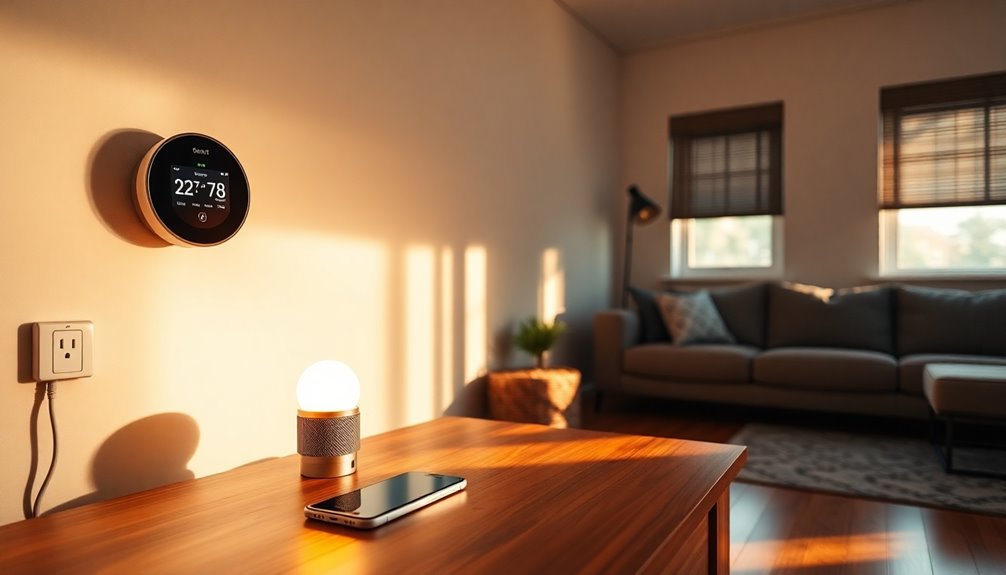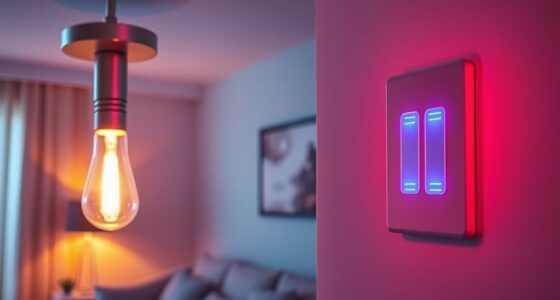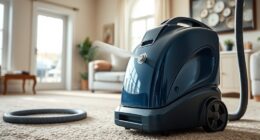You can easily automate your home for under $500 by choosing cost-effective smart devices like smart plugs, lights, and speakers. Start with a smart speaker, such as an Amazon Echo Dot or Google Nest Mini, for voice control. Add smart plugs to manage appliances remotely and Sengled Smart Bulbs for energy-efficient lighting. Consider a budget security camera like the Wyze Cam OG for safety. Make sure to check compatibility with your chosen ecosystem, like Alexa or Google Assistant. With smart planning, you'll enhance your home's convenience and energy efficiency while keeping costs low. There's even more to discover about optimizing your setup.
Key Takeaways
- Start with essential devices like smart plugs, bulbs, and speakers to manage lighting and appliances effectively within your budget.
- Choose compatible devices that work with popular ecosystems like Amazon Alexa or Google Assistant for seamless integration.
- Allocate funds wisely by prioritizing security features such as smart locks and cameras to enhance safety without overspending.
- Plan automation points in your home layout to determine the best placement for devices, maximizing their effectiveness.
- Utilize remote access and voice control capabilities for convenience and energy savings, ensuring all devices are user-friendly and efficient.
Affordable Smart Devices
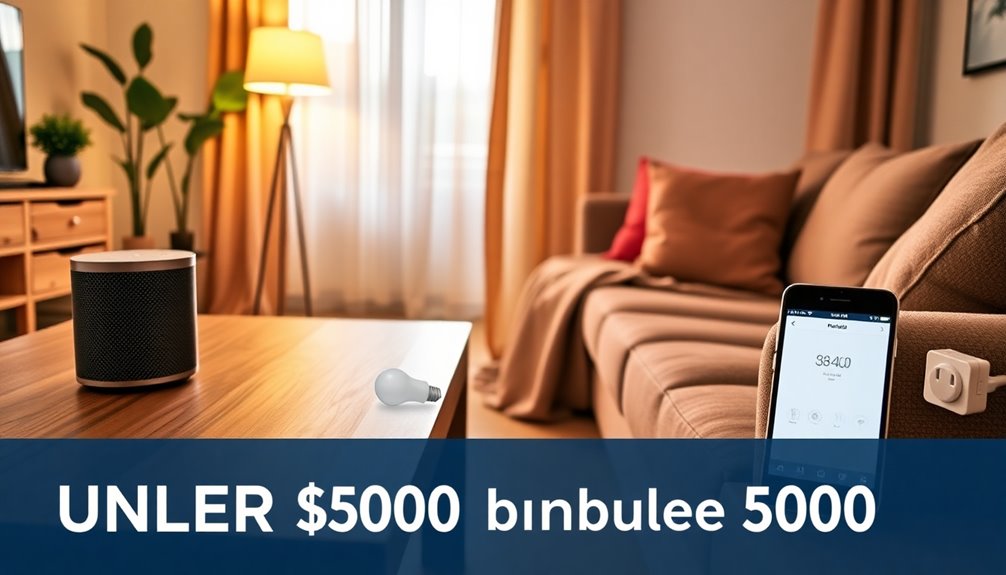
When you're looking to automate your home without breaking the bank, affordable smart devices are a great place to start.
Smart speakers like the Amazon Echo Dot and Google Nest Mini offer voice control for your devices, making them excellent entry points for your smart home. With smart home gadgets available for under $500, you can find a variety of options that suit your needs. Smart home device integration allows for seamless management of your appliances and systems.
You can easily manage various appliances with smart plugs such as the Wemo WiFi Smart Plug or Kasa Smart Wi-Fi Plug, each under $25.
For lighting, consider Sengled Smart Bulbs, which work with multiple systems and help save energy.
Lastly, smart security cameras like the Wyze Cam OG provide peace of mind without costing a fortune.
All these options let you enhance your home's functionality while keeping your budget intact.
Choosing Compatible Brands
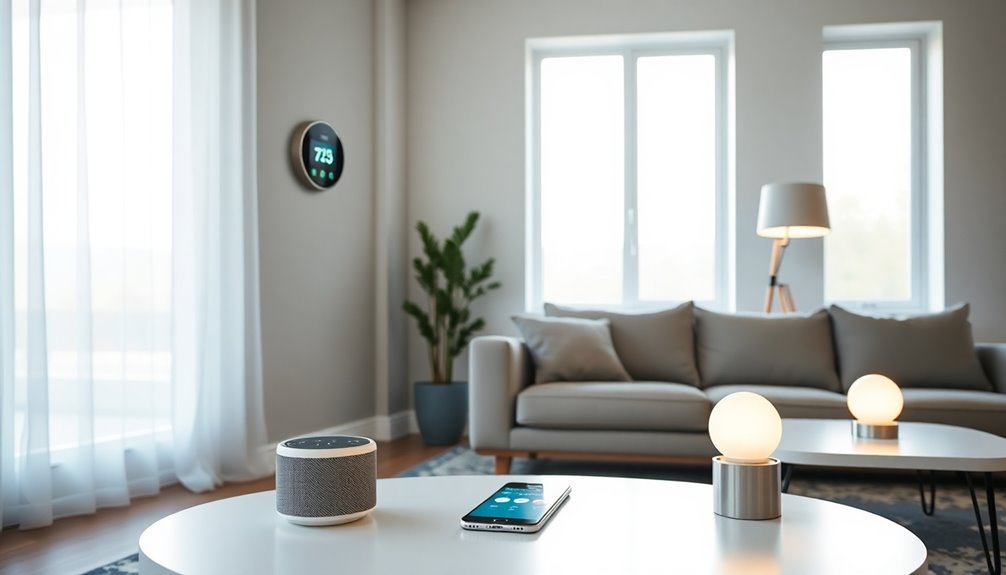
As you dive into automating your home, choosing compatible brands is crucial for a seamless experience.
Start by identifying smart home ecosystems like Amazon Alexa, Google Assistant, or Apple HomeKit, as these can significantly enhance compatibility. Brands such as Ring, Nest, and SimpliSafe are well-reviewed and integrate easily with these platforms. Additionally, incorporating air purifiers with HEPA filters can help improve indoor air quality, complementing your smart home setup.
Look for devices using common control protocols like WiFi, ZigBee, or Z-Wave, which ensure broader compatibility across products. Consider platforms like Samsung SmartThings, which supports a wide range of devices and is backed by over 280 companies. Research customer reviews to verify reliability and user-friendliness.
Don't forget to check if the products fit your budget while still offering innovative features.
Planning Your Automation
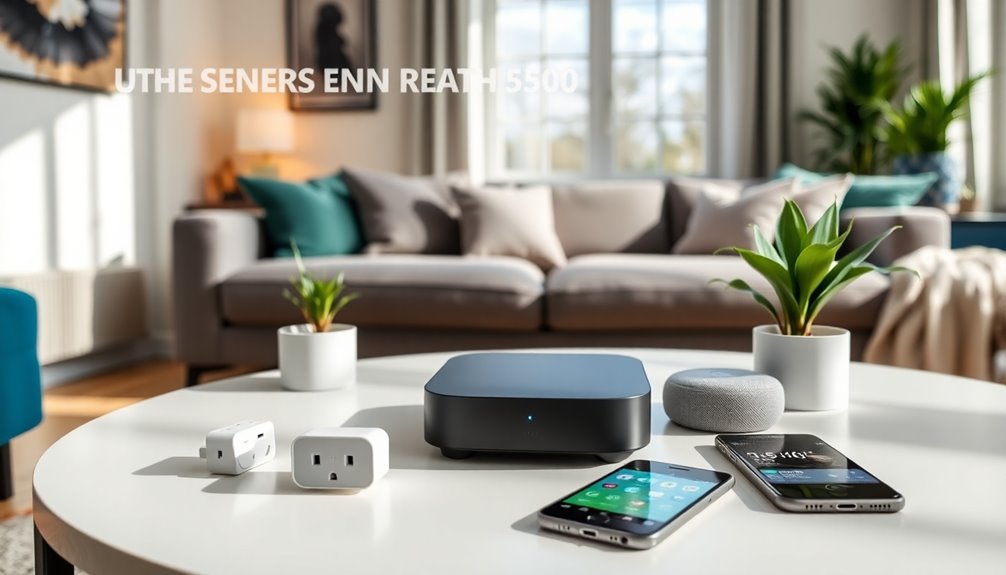
To effectively plan your home automation, start by assessing your needs and defining clear goals.
Evaluate your home layout, noting where you'd like to integrate automation, whether it's lighting, temperature control, or security.
Set a budget to guide your choices, considering the costs of devices and installation.
Research compatible devices that work seamlessly with each other and your chosen hub. Consulting with a custom integrator can help ensure you make the best choices for your specific needs.
Don't hesitate to consult experts for tailored advice.
Additionally, select a central hub that's user-friendly and can support future upgrades.
Create a simple floor plan to visualize device placement, prioritize your automation goals, and think about scalability.
This groundwork will ensure a smoother setup process later on.
Setting Up Your System
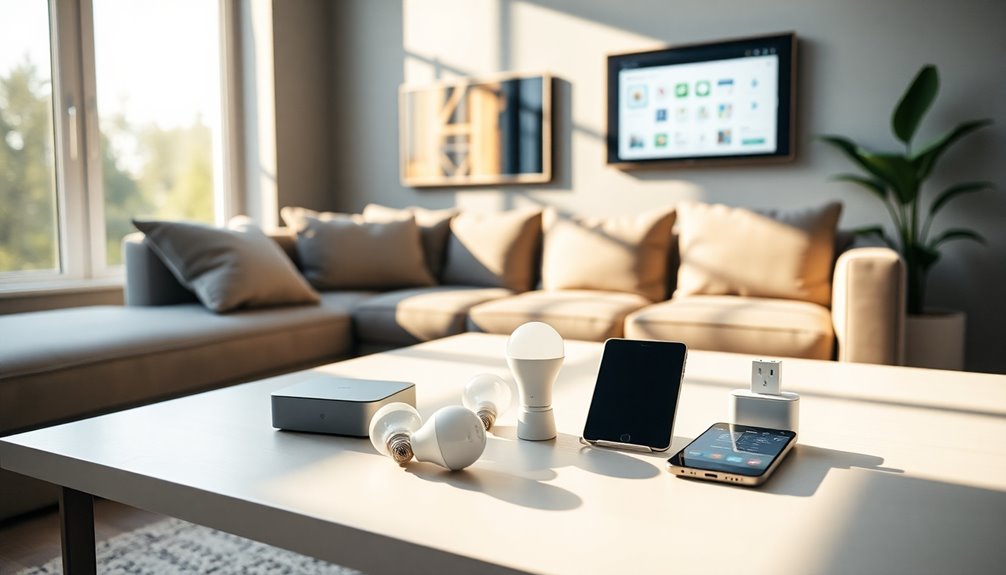
With a solid plan in place, you're ready to set up your home automation system. Start by assessing your needs and prioritizing essential devices like lighting and security cameras.
Ensure these devices are compatible with your chosen central hub and fit within your budget. When selecting a hub, look for one that supports various protocols and integrates well with voice assistants. Additionally, consider how communication technologies will enhance the connectivity between your devices.
Next, research devices that work seamlessly together and check for energy efficiency. Measure and plan device locations carefully to facilitate installation.
Follow manufacturer instructions during setup, connect devices to the hub, and configure settings to match your preferences.
Finally, test each device thoroughly to ensure everything runs smoothly before enjoying your automated home.
Remote Monitoring and Control
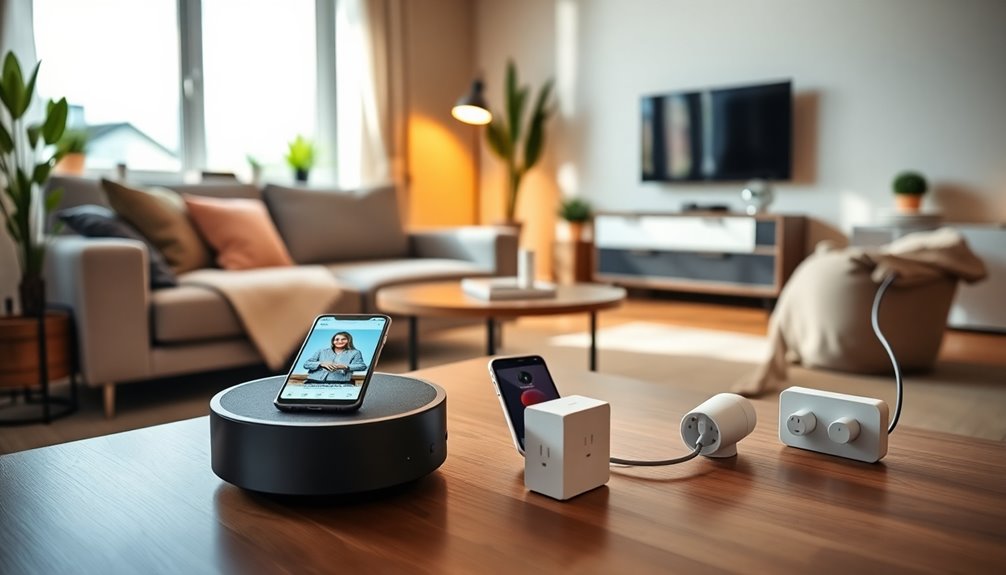
Remote monitoring and control transform the way you interact with your home, giving you peace of mind and convenience at your fingertips. Start by selecting essential devices like smart surveillance cameras for live feeds, smart locks for enhanced security, and smart thermostats for comfortable temperature adjustments. To connect everything, use a compatible central hub like Amazon Echo or Google Home, following the setup instructions carefully. Enable remote access by creating an account and ensuring your devices are configured correctly. Utilize voice assistants for seamless commands and set up automation routines to simplify daily tasks. With smart plugs, you can control various appliances remotely, ensuring your home is secure and efficient, all within your budget. This integration of devices enhances convenience and efficiency in managing your smart home environment. Additionally, consider investing in a best home security system to further enhance your overall security setup at home.
Energy Efficiency Optimization
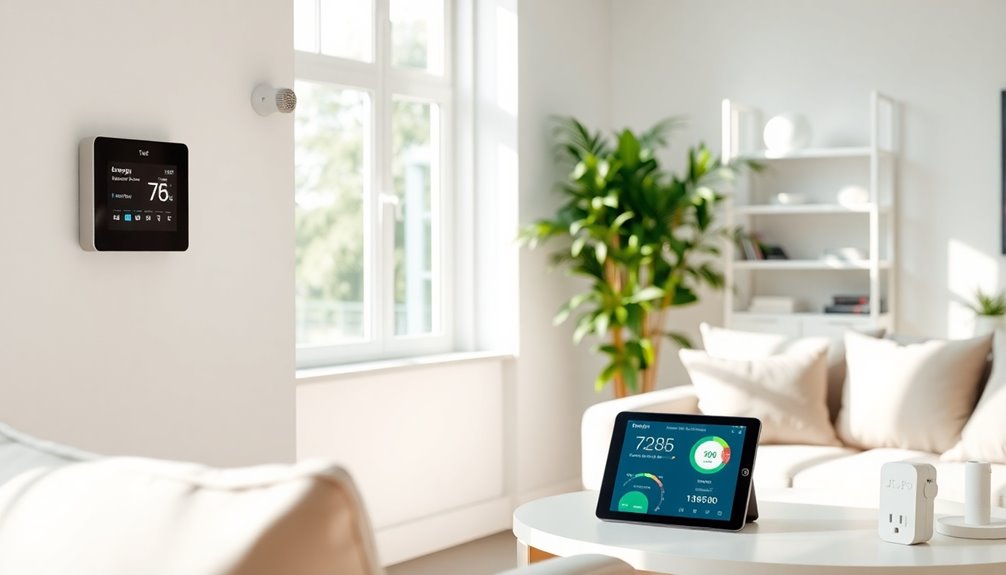
As you seek to make your home more energy-efficient, integrating smart technology can significantly cut costs and reduce your environmental footprint.
Smart thermostats adjust temperatures based on occupancy and weather, saving you 10-30% on your energy bills. They learn your habits, keeping your home comfortable while minimizing energy waste. Additionally, using smart thermostats can reduce heating and cooling costs by 10-15%. Smart utilities can further enhance your energy management by providing real-time monitoring of usage.
Automated lighting systems, scheduled to turn on and off, help you use energy only when needed, adjusting based on natural light levels.
Smart appliances let you schedule energy use during off-peak hours for added savings.
Furthermore, smart plugs eliminate "vampire" energy use by turning off devices when not in use, ensuring you maximize your energy efficiency without sacrificing convenience.
Embrace these technologies for a more sustainable home.
DIY Automation Projects
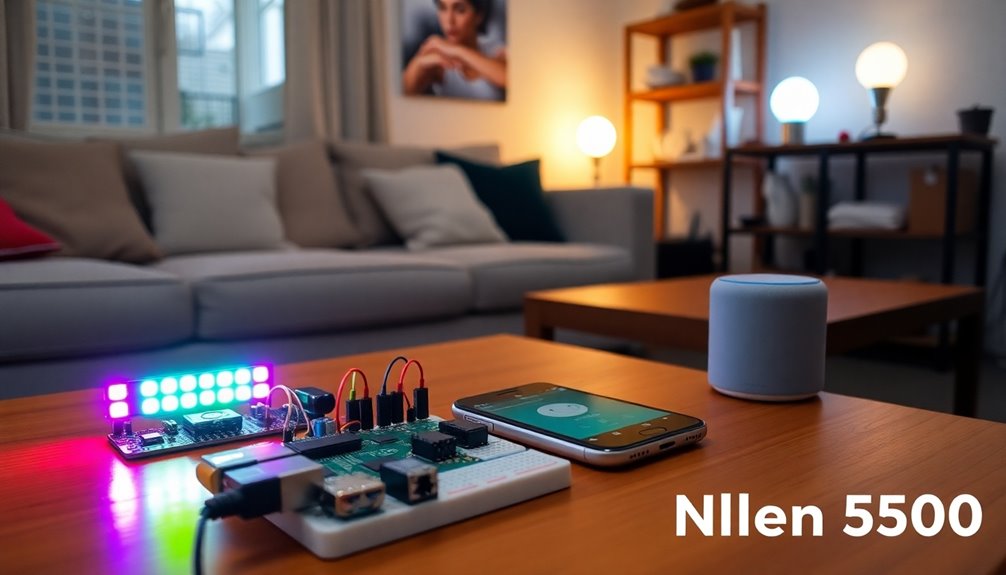
Transforming your home into a smart haven doesn't have to break the bank; you can kickstart your DIY automation projects for under $500.
Start with smart lighting by installing Philips Hue or Wyze bulbs, allowing you to control your lights via voice or smartphone. You can set schedules and even connect these bulbs to motion sensors for automatic illumination. Additionally, you can create customizable light scenes for different moods, enhancing the user experience in your home. Investing in diversification benefits through smart home devices can further enhance your automation strategy.
Next, enhance your home security with budget-friendly cameras like Ring or Wyze. Monitor your home remotely and set alerts for suspicious activity.
For temperature control, consider smart thermostats that adjust based on your presence. Finally, integrate voice-controlled systems to manage devices like coffee makers and fans.
These projects not only elevate convenience but also keep costs low.
Budget Allocation Strategies
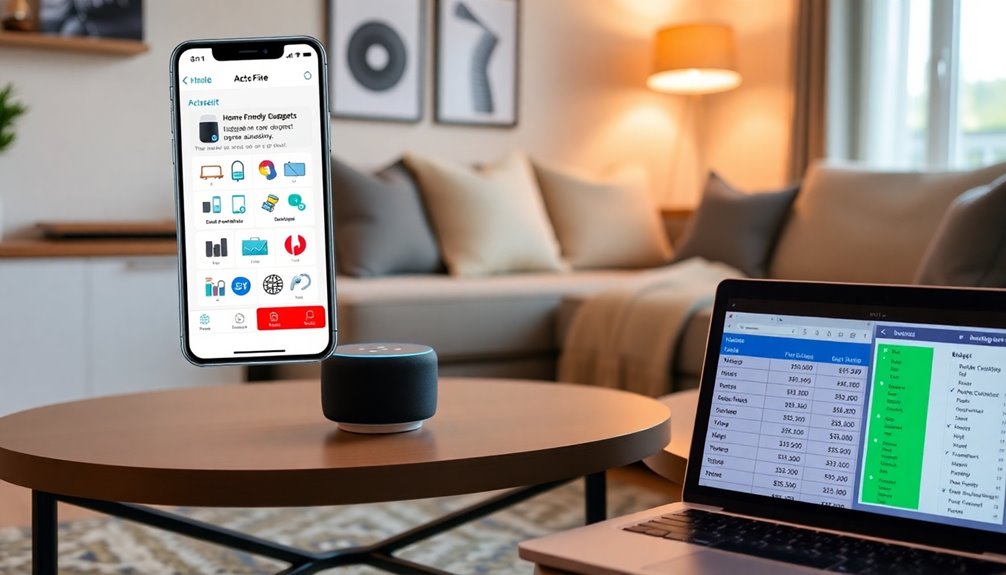
To make the most of your home automation budget, it's crucial to define your goals and prioritize your needs.
Start by identifying core functionalities that matter most, like energy savings or security. Allocate a significant portion of your budget to these critical features while setting realistic expectations. Implementing smart devices can significantly enhance your home's energy efficiency, especially when considering energy savings strategies that help you reduce overall costs.
Conduct thorough research to understand system costs and compare devices for the best value. Seeking professional consultation can provide insights into budget-friendly solutions and phased implementations.
Don't forget to determine your overall budget and divide it among hardware, software, installation, and maintenance.
Finally, always set aside contingency funds for unexpected expenses and regularly review your budget allocation to stay on track with your project.
Future Expansion Considerations
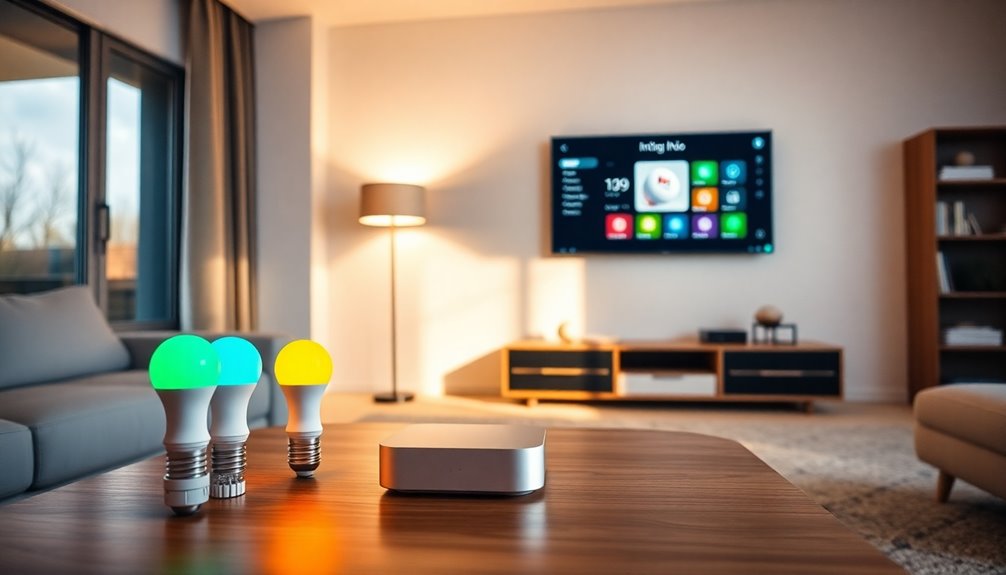
When planning your home automation, it's essential to consider future expansion to ensure your system remains relevant and functional as technology evolves.
Think about integrating advanced technology like AI and machine learning, which can learn your preferences and adjust settings automatically. The Internet of Things (IoT) is also expanding, making it possible for more devices to connect and communicate efficiently. Smart home market growth indicates a rising interest in home automation, signaling that investing in these technologies now can enhance your home's value. Additionally, exploring the AI capabilities that exceed traditional methods can further elevate your automation experience.
As you add smart appliances, consider those that enhance security by adjusting automatically based on your presence. Voice and gesture control will enhance your experience, allowing for intuitive interactions.
Finally, explore how augmented and virtual reality can transform your living space, providing immersive control and personalized settings. Planning for these advancements ensures your home remains cutting-edge.
Frequently Asked Questions
What Are the Best Budget-Friendly Smart Home Brands?
When you're looking for budget-friendly smart home brands, consider Amazon, Google, Wyze, and Atomi.
Amazon offers devices like the Echo Dot and Smart Plug, both affordable and easy to integrate. Google's Nest Mini is another great option.
For security, check out Wyze's camera and smart plug, while Atomi provides versatile smart lighting solutions.
Each brand brings unique features that can enhance your home without breaking the bank.
How Can I Ensure Device Compatibility?
To ensure seamless device compatibility, start smartly by selecting systems that support widely used protocols like Z-Wave or Zigbee.
These options offer a plethora of products that play well together.
Next, prioritize profiles, choosing devices designed to work within the same framework.
Don't forget to check manufacturer support for integration and consider using dongles for added flexibility.
This way, you can create a cohesive and connected smart home experience without hassle!
Are There Free Apps for Home Automation?
Yes, there are several free apps for home automation that you can explore.
OpenHAB and Home Assistant stand out for their extensive device compatibility and user-friendly interfaces, making them ideal for beginners and tech enthusiasts alike.
Domoticz offers flexibility across various platforms, while Calaos allows for simple one-click automation.
If you're looking for a versatile option, consider MisterHouse, though it might require some technical knowledge to maximize its features.
What Should I Prioritize First in My Automation System?
When it comes to home automation, think of it as building a fortress of convenience. You should prioritize security first—install motion sensors, smart locks, and surveillance cameras to protect your home.
Next, focus on lighting; smart systems can enhance your environment effortlessly.
Convenience follows, with smart speakers and thermostats that make daily tasks easier.
Finally, consider energy efficiency to save on costs while enjoying a more automated lifestyle.
Can I Automate My Home With Only Smart Plugs?
Yes, you can automate your home using only smart plugs. They let you control various appliances, like lamps and coffee makers, through your smartphone or voice assistant.
You can set schedules, turn devices on or off remotely, and even monitor energy usage.
While smart plugs provide great convenience, consider how many devices you want to automate and if you might eventually want to expand your system with other smart home devices.
Conclusion
By automating your home for under $500, you're not just saving money; you're also stepping into a smarter, more efficient lifestyle. Did you know that smart home devices can reduce energy costs by up to 30%? With the right planning and a bit of creativity, you'll enjoy enhanced comfort and convenience while staying within budget. So, dive in and explore the exciting world of home automation—your wallet and your home will thank you!
